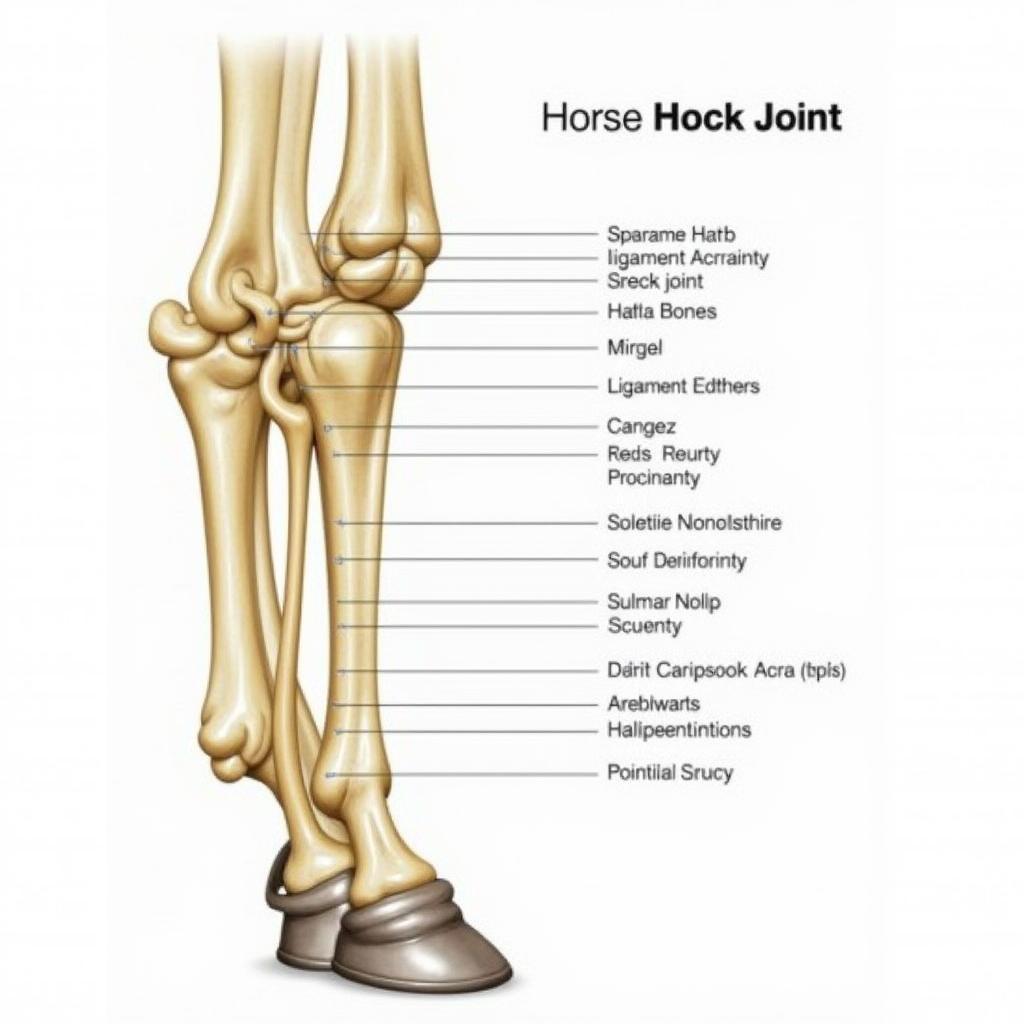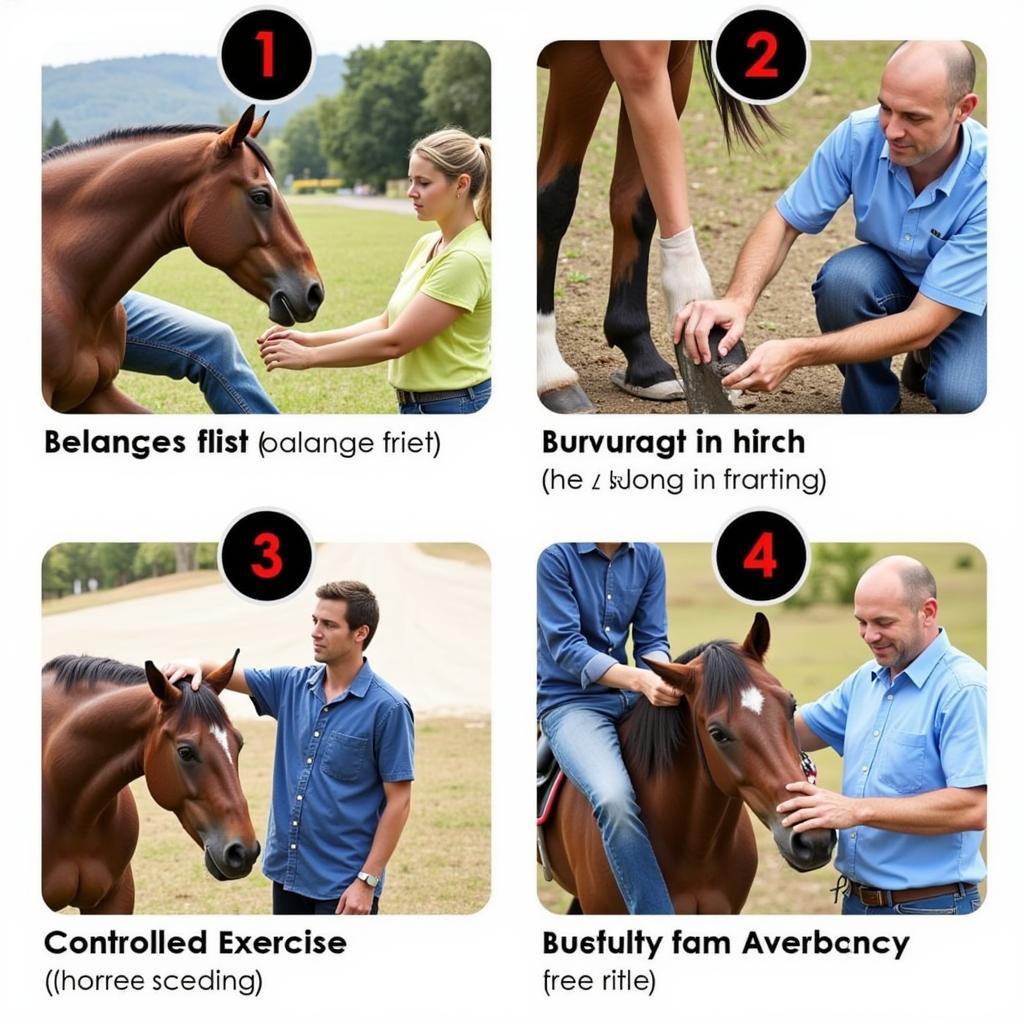The hock joint plays a critical role in a horse’s ability to move gracefully and powerfully. Located on the hind leg, the hock is often compared to a human ankle, facilitating a range of motion vital for everything from a collected canter to a powerful jump. Understanding the anatomy and function of the hock is crucial for any horse owner, enabling early detection of potential issues and ensuring optimal performance and well-being.
The Equine Hock: A Closer Look
While the analogy to the human ankle is helpful, the equine hock is a more complex structure. It’s not a single joint, but rather a series of smaller joints working in harmony. These include:
- Tibiotarsal joint: The largest joint in the hock, connecting the tibia (shin bone) to the talus (one of the bones in the hock).
- Proximal intertarsal joint: Positioned between the talus and calcaneus (the point of the hock).
- Distal intertarsal joint: Located between the lower row of hock bones and the metatarsals (the bones above the fetlock).
 Equine Hock Anatomy
Equine Hock Anatomy
Why is the Hock Important?
The hock serves as the primary center of propulsion in a horse. Think of it as the engine driving their movement. Every time a horse pushes off the ground, the hock joint bends, storing energy like a spring. This stored energy is then released, propelling the horse forward.
Given its critical role, the hock is subjected to significant stress, particularly during activities like jumping, turning, or working at speed. This makes it susceptible to a variety of injuries and conditions.
Common Hock Problems in Horses
A range of factors can impact the health of a horse’s hock, including genetics, conformation, and workload. Some common problems include:
- Bog Spavin: An accumulation of fluid in the tibiotarsal joint, often caused by inflammation or trauma. This can result in a soft, puffy swelling at the front of the hock.
- Bone Spavin: Also known as osteoarthritis, bone spavin involves the degeneration of the cartilage and bone in the lower hock joints. Lameness, especially when turning, is a common sign.
- Curb: A thickening or sprain of the plantar ligament, which runs along the back of the hock. This condition often results from overextension of the hock, such as during a strenuous jump.
 Common Horse Hock Conditions
Common Horse Hock Conditions
Recognizing Signs of Hock Problems
Early detection is key to managing hock issues effectively. Be vigilant for any changes in your horse’s gait, behavior, or the appearance of their hocks. Signs to watch for include:
- Lameness: This may be subtle, such as a shortened stride or reluctance to work on a particular lead.
- Swelling: Any unusual puffiness or heat around the hock should be evaluated by a veterinarian.
- Pain on Palpation: If your horse reacts negatively when you touch their hock, it could signal discomfort.
- Difficulty Flexing or Extending the Hock: This may indicate stiffness or pain within the joint.
Keeping Your Horse’s Hocks Healthy
Maintaining healthy hocks requires a multifaceted approach:
- Regular Exercise: Consistent, controlled exercise helps maintain joint flexibility and muscle strength, crucial for supporting the hock.
- Proper Shoeing: Correct hoof care and shoeing can significantly impact the biomechanics of the hock, reducing stress and strain. Consult with a qualified farrier for optimal hoof balance.
- Appropriate Workload: Avoid overworking your horse, particularly in disciplines that place high demands on the hocks, such as jumping or reining.
- Nutritional Support: Provide a balanced diet with adequate vitamins and minerals, such as copper and zinc, to support joint health.
- Early Veterinary Attention: Address any signs of hock problems promptly by seeking veterinary attention. Early intervention often leads to better outcomes.
 Maintaining a Healthy Horse Hock
Maintaining a Healthy Horse Hock
Conclusion
The hock is a marvel of equine anatomy, enabling the grace and power we admire in horses. By understanding its structure and function, recognizing potential problems, and prioritizing preventative care, we can help our equine partners enjoy long, healthy, and active lives. If you suspect your horse may have a hock issue, don’t hesitate to contact your veterinarian for a comprehensive evaluation and treatment plan.
FAQs about Horse Hocks
1. Are certain breeds more prone to hock problems?
Yes, some breeds are genetically predisposed to certain hock conditions. For instance, Standardbreds and Thoroughbreds are more likely to develop bone spavin, while Quarter Horses may be more susceptible to curb.
2. Can hock problems be treated successfully?
The prognosis for hock problems varies depending on the specific condition, its severity, and the horse’s individual response to treatment. Early diagnosis and intervention typically yield the best results.
3. How long does it take for a hock injury to heal?
Healing time depends on the nature and severity of the injury. Minor sprains might heal within a few weeks, while more serious conditions like bone spavin can require months of rehabilitation.
4. Can I prevent hock problems in my horse?
While not all hock problems are preventable, following the preventative care tips outlined above can significantly reduce the risk.
5. When should I call the vet for a hock problem?
If you notice any lameness, swelling, heat, or behavioral changes related to your horse’s hock, contact your veterinarian immediately.
Need more help?
For more information on caring for your horse’s legs, check out our articles on hock sores on horses and the benefits of using pro choice horse boots.
We also have interesting reads on horse popping and how hot is too hot for horses, so feel free to explore our website!
For any further questions or concerns, please don’t hesitate to contact us. Our team at Justus Horses USA is dedicated to providing you with the best possible care for your equine companions. Call us at 0772127271, email us at [email protected], or visit us at QGM2+WX2, Vị Trung, Vị Thuỷ, Hậu Giang, Việt Nam. We are here for you 24/7.